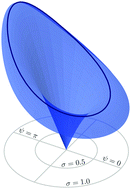Non-monotonic, lily-like twist distribution in toroidal nematics†
Abstract
Toroidal nematics are droplets of nematic liquid crystals in the form of a circular torus. When the nematic director is subject to planar degenerate boundary conditions, the bend-only director field with vector lines along the parallels of all nested torodial shells is an equilibrium solution for all values of the elastic constants. Local stability analyses have shown that an instability is expected to occur for sufficiently small values of the twist elastic constant. It is natural to wonder whether in this regime the global equilibrium would be characterized by a monotonic twist, or not. In the former case, the twist distribution over the torus' circular cross-section would be represented pictorially by a fennel-like surface emanating from the centre. We prove that instead the stable twist distribution is represented by a lily-like surface. Thus, generically the twist distribution is not monotonic and its maximum may fall well within the torus, far away from the boundary. To cope with the peculiar complexity of the elastic free-energy functional in the fully non-linear setting, we developed an ad hoc deep-learning optimization method, which here is also further validated and documented for it promises to be applicable to other similar problems, equally intractable analytically.



 Please wait while we load your content...
Please wait while we load your content...